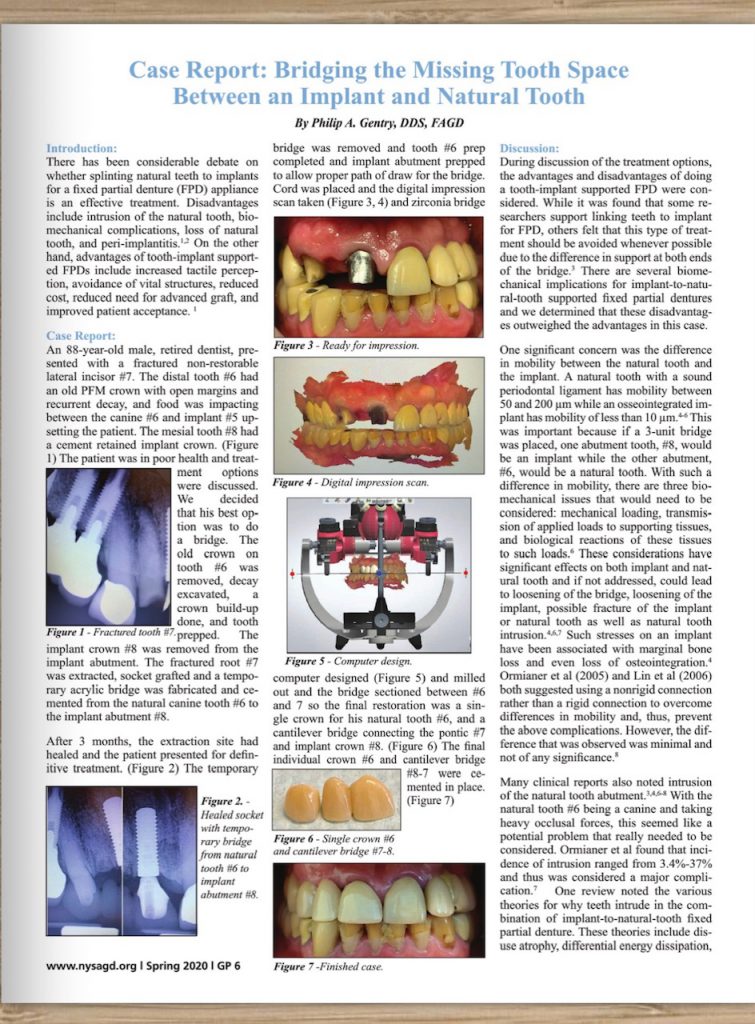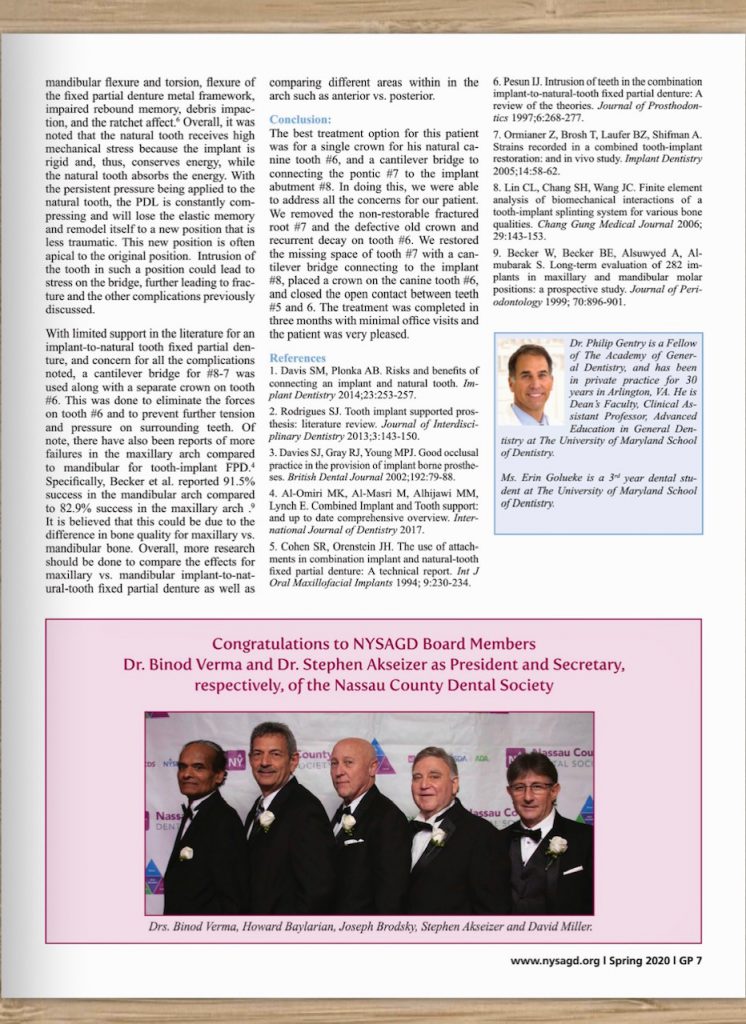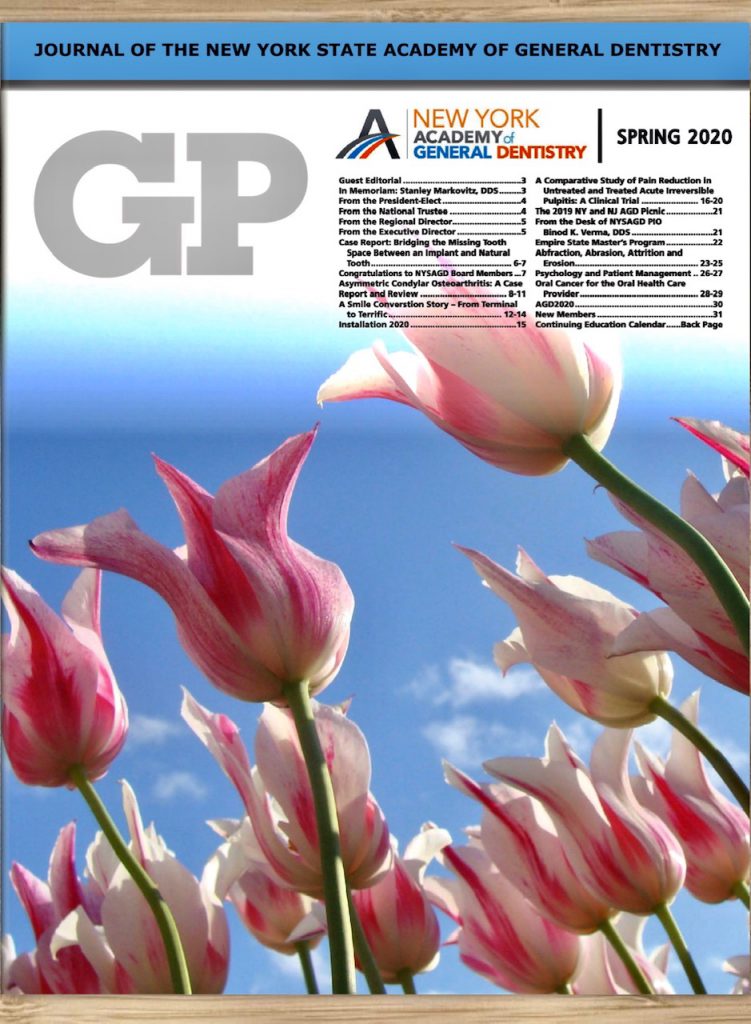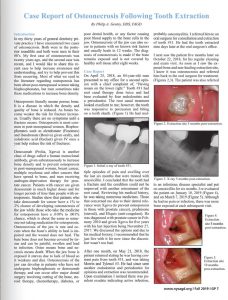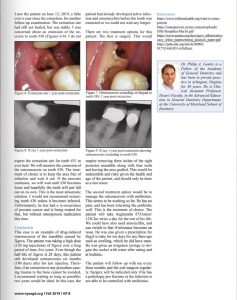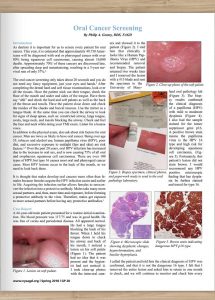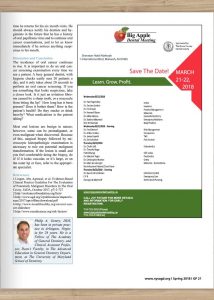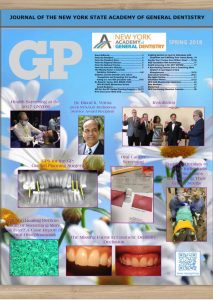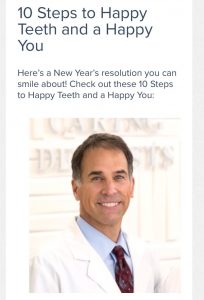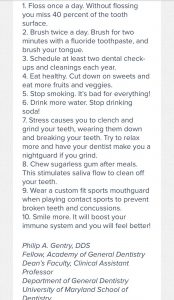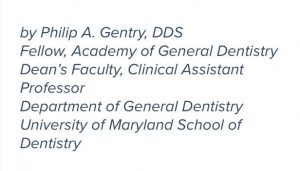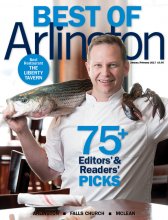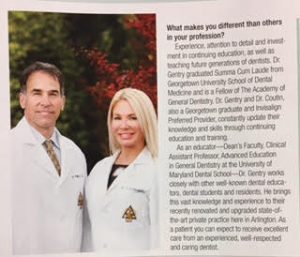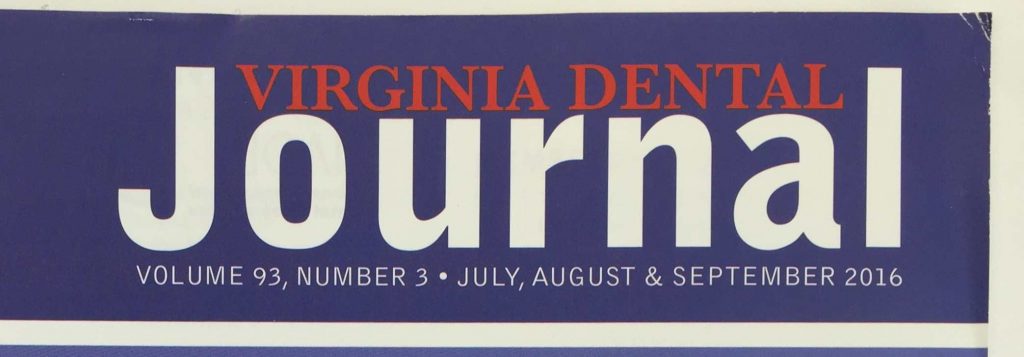My latest article published in The Journal of The New York State Academy of General Dentistry.
Category Archives: articles/publications
Dr. Gentry’s article published in The Journal of The New York State Academy of General Dentistry
Shark Week-Shark’s Teeth!!!
In honor of Shark Week, I wrote an article on shark’s teeth :-)))

Sharks are born with a full set of teeth.
Our baby teeth form during the 6th-8th week of prenatal development and begin erupting at about 6 months of age. Unlike humans, shark pups enter the world with a full set of teeth and can fend for themselves.
Sharks have lots of teeth.
Our 20 primary, or baby teeth, fully erupt by 2-3 years old. The adult permanent molars begin to show in the mouth at 6-7 years old, and by age 13, we have 28 permanent teeth. The 4 wisdom teeth start to push out at 17-21 years old. That’s a total of 20 baby teeth and 32 adult permanent teeth. Most sharks have 5-15 rows of teeth. The bull shark has 50 rows of teeth, and up to 350 teeth erupted in their mouth at one time!
Shark’s continuously lose and replace their teeth.
A lost permanent tooth is unable to replace itself naturally. Sharks typically break off and lose at least 1 tooth a week. When a shark’s tooth falls out, another spins forward like a conveyor belt from their rows of backup teeth. The dull, broken or worn teeth are quickly replaced by a sharp new tooth. A shark may grow and use over 50,000 teeth in it’s lifetime!
Both the sharks upper and lower jaws move and it swallows it’s food whole.
We use our teeth to bite and chew food. Sharks have the strongest jaws on the planet and unlike most animals sharks can move both their lower and upper jaws! Sharks use their teeth to grab, hold and rip prey and swallows its food whole.
If there was a Shark Tooth Fairy, they would be rich fish.
According to the 2017 Delta Dental Tooth Fairy Poll of parents of kids 6-12 years old, the average pay out per lost tooth is $4.13. Kids have 20 baby teeth, for a total of $82.60. For an average shark who loses 20,000 teeth, that would be $82,600!
Shark teeth have cavity protection.
Sharks don’t get cavities; their teeth surface naturally contains fluoride! Fluoride makes teeth stronger and more resistant to bacteria that cause tooth decay. The teeth of humans and other mammals contain the mineral, hydroxyapatite, which is also found in bone. Fluoride in toothpastes, drinking water and applied by dentists, makes our teeth stronger by interacting with the hydroxyapatite to form the stronger fluorapatite.
Dr. Gentry’s Article Published in The Journal of The New York State Academy of General Dentistry, Spring 2018
Dr. Gentry’s Article on How to Brush Your Dog’s Teeth.

Dr. Gentry with his dog, Luna, who often accompanies him to the office
Want to keep your pooch’s pearly whites in tip-top condition? Local dentist (and devoted dog owner) Philip Gentry offers this step-by-step advice for keeping Fido’s smile healthy and clean:
1. Use a specially designed dog toothbrush and pet toothpaste. Never, never, use human toothpaste. It’s not meant to be swallowed and will irritate a dog’s stomach. Two brands that I recommend are Sentry Petrodex Enzymatic toothpaste for dogs (poultry or peanut butter flavor) or Arm & Hammer’s Advanced Pet Care Enzymatic dog toothpaste (chicken or beef flavor).
2. Gently introduce the toothpaste by allowing your dog to lick it off your finger. Do this first, before you bring a toothbrush into the picture.
3. Next, use your finger to rub the toothpaste around the outside of the teeth and gums. Avoid the inside surface so as not to be bitten.
4. Once your dog gets used to the drill, you can introduce a toothbrush. Be sure to consider the size of your dog when choosing a toothbrush (smaller brush and head for a small dog; larger and longer brush for a bigger dog). Look for a soft brush that has bristles on both sides of the handle. Pet stores also sell finger brushes that fit over your fingertip.
5. Brush daily at a relaxed time in a location with plenty of light. Start brushing the front teeth and work backward, moving the brush in a circular motion. Lift the dog’s lip so you can see better.
6. Reward your pup with praise and petting. Make it a fun experience. It’s okay to give treats, too—ideally dental chews that are specifically designed to remove plaque and tartar. I like Greenies brand.
7. Avoid giving your dog table scraps and sweets. They will cause plaque build-up, decay and gum disease. Note: the sweetener Xylitol (which is found in candy, gum, human toothpaste, certain protein bars and other products) is toxic to dogs! Click here for a complete list of products that contain Xylitol.
8. Don’t stress if you can’t reach all of your dog’s teeth. Start the very first brushing with a goal of doing 10 seconds on the front teeth. Then work your way up to one minute, brushing all the teeth.
Related Stories:
Dr. Gentry’s 10 Steps to Happy Teeth and a Happy You :-)))
Here’s a New Year’s Resolution You can Smile About! Ten Steps to Happy Teeth and a Happy You:
- Floss once a day. Without flossing you miss 40% of the tooth surface.
- Brush twice a day. Brush for 2 minutes with a fluoride toothpaste, and brush your tongue.
- Schedule at least 2 dental check-ups and cleanings each year.
- Eat healthy. Cut down on sweets and eat more fruits and veggies.
- Stop smoking. It’s bad for everything!
- Drink more water. Stop drinking soda!
- Stress causes you to clench and grind your teeth, wearing them down and breaking your teeth. Try to relax more and have your dentist make you a nightguard if you grind.
- Chew sugarless gum after meals. This stimulates saliva flow to clean off your teeth.
- Wear a custom fit sports mouthguard when playing contact sports to prevent broken teeth and concussions.
- Smile more. It will boost your immune system and you will feel better :-)))
Dental care during the holidays
Best of Arlington
Dr. Gentry’s editorial published in The Virginia Dental Journal
Smokeless Tobacco Effects on Dental Health- Please Quit
With cigarette smoking becoming socially unacceptable and prohibited in many areas, some, especially high school boys, are using smokeless tobacco. Smokeless tobacco includes chew, spit, dip, snuff, snus, and any dissolvable tobacco product. Many people believe these products are safer than smoking. This is not true! With the tobacco in contact with your gums for long periods of time, you will become addicted and dangerous consequences will occur. Nicotine in tobacco is what causes the addiction. One small can of chewing tobacco contains 144 milligrams of nicotine, which is equivalent to 80 cigarettes.
Chewing tobacco will cause the following to your mouth:
- Stained teeth- Your teeth will look ugly.
- Bad breath- Your mouth will stink.
- Tooth decay- Tobacco juice and added sugars for flavor cause cavities.
- Loss of taste and smell- Can’t enjoy food.
- Gum recession and gum disease- Gums loss and teeth will fall out.
- Leukoplakia- Premalignant white patches on gums that can lead to cancer.
- Cancer- Tobacco contains 28 cancer causing chemicals.
If you use any type of tobacco you need to stop immediately! Smoking 1 cigarette causes 1.8 milligrams of nicotine to be absorbed into the blood, while a pinch of chewing tobacco allows 3.6 to 4.5 milligrams of nicotine to enter the bloodstream. Nicotine is highly addictive. Upon entering the bloodstream, it immediately stimulates the adrenal glands to release epinephrine, which stimulates the brain to increase blood pressure, respiration, and heart rate, giving the user a “kick”. Nicotine, just like heroin and cocaine, also increases the levels of the neurotransmitter, dopamine, which control the brain’s reward and pleasure pathways. Although there is more nicotine in chewing tobacco, research has shown the withdrawal symptoms are equivalent. Nicotine is toxic and is actually the tobacco plants natural insecticide against being eaten by insects. For centuries gardeners have used a home-made mixture of tobacco and water to kill insects.
In order to stop, you need to set up a Quit Date and come up with a Quitting Plan! In my opinion, the best way is to decide you really want to quit. Get psyched up and do it! Quit “cold turkey” or try slowly cutting back by using less and less each time and switch to a product containing less nicotine. Substitute sugar free gum or sunflower seeds. Surround yourself with a support group of people who do not use tobacco. Visit your dentist and get your teeth cleaned so your mouth feels fresh and clean. Exercise and keep busy.
Quitting will be difficult. Nicotine is about as addictive as heroin and crack cocaine, and more addictive than crystal meth, alcohol, and cocaine. You have become physically and emotionally addicted and quitting causes unpleasant withdrawal symptoms. These include:
- dizziness
- depression
- anxiety
- feelings of frustration
- impatience and anger
- irritability
- trouble sleeping
- difficulty concentrating
- restlessness, headaches, tiredness
- increased appetite, weight gain
- slower heart rate
For those that need extra help, consult your dentist or primary care physician to discuss if any medicines can help. Using some form of nicotine replacement therapy such as nicotine gum, patch, lozenges, inhaler, or nasal spray can double your chances of quitting. Here are some medicines to consider:
- Commit®
- CHANTIX*
- Habitrol
- Nicoderm CQ
- Nicorette
- Nicotrol®/Nicotrol® NS
- NiQuitin CQ
- Zyban
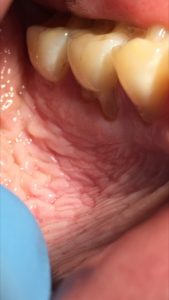
Smokeless tobacco is just as bad as smoking cigarettes. Smokeless tobacco is disgusting, causes gum disease, and tooth decay, and is a waste of money. Smokeless tobacco users have an 80% higher risk of oral cancer and a 60% higher risk of pancreatic and esophageal cancer. If you use both tobacco and alcohol your cancer risk is 100% greater than non-users. Smokeless tobacco products increase the risk of heart attack and stroke. It even says so on the label. Please quit!
Dr. Philip A. Gentry, DDS
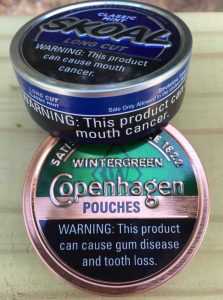
Dr. Gentry’s list of 15 foods that stain teeth.
Article published in The University of Maryland Magazine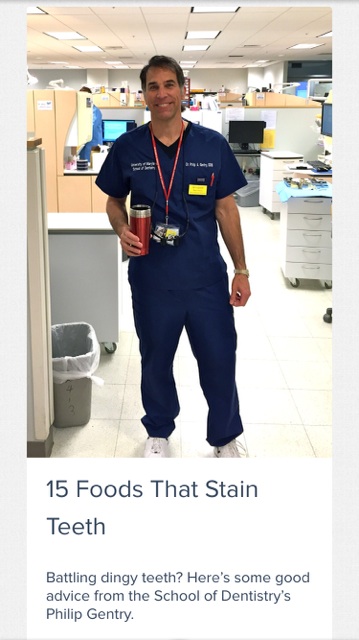
- Coffee
Your morning cup of Joe might be a necessity that you cannot live without. However, coffee contains dark pigments and healthy but acidic polyphenols, and tannins that can lead to staining and discoloration. Plus, coffee is also very acidic, and acidic foods lead to tooth decay.
- Tea
Tea has stain-causing tannins. If you’re constantly sipping on tea throughout the day, avoid Earl Grey and choose a lighter colored variety such as an herbal or green tea. To fight against tea stains, research published in the International Journal of Dental Hygiene says to add a little milk to your cup! The casein in milk was found to significantly prevent and reduce tea-induced stains.
- Red Wine
Those same troublesome tannins exist in your favorite glass of vino, too. Try pairing your glass of Pinot Noir with a handful of almonds to help counteract staining. The act of chewing hard foods like nuts can help scrub away plaque from teeth and mitigate staining. Swish out with water immediately after drinking wine.
- Berries
Blueberries, raspberries, and strawberries are very healthy and packed with antioxidants, but due to their darker hues, berries will cause staining of the teeth. Eat berries and brush right after.
- Curry
Although the exotic spices taste amazing, those yellow and red yummy spices also tint your teeth, thanks to their deep pigmentation. The best way to prevent staining here is to make curry an “every once in awhile” treat. Your smile will thank you.
- Hard Candies
Hard candies like Jolly ranchers might be one of the worst foods for your teeth. They are both sticky and acidic. Choose non-sticky dark chocolate instead.
- Tomato Sauce and Ketchup
Anything that can stain your clothes can stain your teeth. Tomatoes are also acidic. Brush after your spaghetti and meatballs.
- Cherry and Cranberry Juice
All fruit juice puts your teeth at risk of discoloration, especially when the fruits are richly pigmented like cherries or berries. Not to mention, fruit juice is often stacked high in sugar, which can act as a breeding site for bacteria in your mouth and lead to more dental damage and discoloration.
- Soda
Regular and diet soda is very acidic to the body and, as a result, is damaging to your dental health. Drinking plain water is the best choice for your teeth. Drinking through a straw may help a little.
- Balsamic Vinegar and Soy Sauce
Salads are healthy for you, but that balsamic may do a number on your teeth. Not only is balsamic dark in color, but it’s rather sticky and will latch onto teeth, which can lead to staining if it’s not brushed away soon after eating. Avoid too much soy sauce, it stains and contains too much sodium anyway.
- Beets
Whether you enjoy them in your morning veggie juice or consume them whole, beets can be incredibly staining to the teeth. Brush your teeth after eating beets. You can also try pairing them with foods that are less damaging to your mouth—like cheese! Studies show that cheese can reduce acids in the mouth.
- Popsicles
Popsicles may be lower in calories than other dessert options, but due to their sugar content and fruit juice base, and will stain your teeth. Chew sugarless gum instead to increase your saliva production, which helps to neutralize and counteract those acid attacks.
- Gatorade
Some research suggests sports drinks are even more harmful to your smile than sodas. Researchers from New York University found that excessive consumption of these types of drinks can weaken and damage the tissue in your teeth because of a combination of acidic components, sugars, and other additives.
- Grapes
If wine will turn your smile dark, then you better believe its main ingredient will do the same. Grapes are deeply pigmented fruits and may cause staining when eaten often. Brush after eating grapes.
- Lemon
Hot water with lemon in the morning has become a popular with celebrities. But citrus fruits like lemon or lime are highly acidic and can erode the enamel on your teeth—in turn, revealing yellow dentin tissue below. Avoid acids, drink water.
